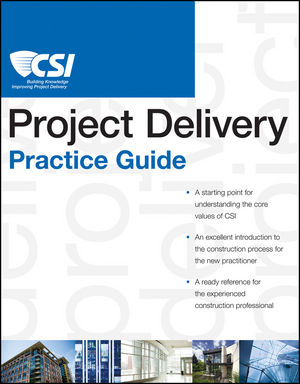The CSI Project Delivery Practice GuideISBN: 978-0-470-63519-3
Paperback
496 pages
January 2011
 This title is out-of-print and not currently available for purchase from this site.
|
Acknowledgments.
Chapter 1: Introduction to The CSI Project Delivery Practice Guide.
1.1 Introduction.
1.2 Understanding Project Delivery as Foundational Knowledge.
1.3 Magnitude of Design and Construction Information Available.
1.4 Managing Information.
1.5 The Nature of the Project and Facility.
Chapter 2: Stakeholders and Participants.
2.1 Introduction.
2.2 The Owner Team.
2.3 The Design Team.
2.4 The Contractor Team.
2.5 The Supplier Team.
2.6 Team Selection Process.
2.7 Partnering and Collaboration.
2.8 Commissioning.
Chapter 3: Facility Life Cycle.
3.1 Introduction.
3.2 The Nature of the Facility Life Cycle.
3.3 Integrated Project Delivery.
3.4 Construction Specifications Institute.
Chapter 4: Codes, Regulations, and Standards.
4.1 Introduction.
4.2 Authorities Having Jurisdiction.
4.3 Codes.
4.4 Regulations.
4.5 Standards.
4.6 Associations, Societies, Councils, and Institutes.
Chapter 5: Contracts and Legal Issues.
5.1 Introduction.
5.2 Owner, Architect/Engineer, and Contractor Tripartite Relationships.
5.3 Elements of a Contract.
5.4 Standard Agreement Forms.
5.5 Example—Contract between Owner and Contractor.
5.6 Contract Types.
5.7 Form of Agreement.
5.8 Compatibility of Agreements.
5.9 Design Team Coordination.
5.10 Important Legal Issues.
Chapter 6: Project Planning.
6.1 Introduction.
6.2 Project Conception.
6.3 Due Diligence Investigations.
6.4 Site Selection.
6.5 Facility Programming.
6.6 Facility Performance Criteria.
6.7 Anticipating the Cost of the Work.
6.8 Setting the Scheduling.
Chapter 7: Project Delivery.
7.1 Influencing Factors.
7.2 Design-Bid-Build.
7.3 Design-Negotiate-Build.
7.4 Construction Management.
7.5 Design-Build.
7.6 Owner-Build.
7.7 Integrated Project Delivery.
Chapter 8: Design.
8.1 Introduction.
8.2 Dual Nature of Design.
8.3 Design Considerations.
8.4 Aesthetics.
8.5 Functional Requirements.
8.6 Constructability.
8.7 Sustainability.
8.8 Design Phases.
8.9 Quality Assurance/Quality Control Requirements.
8.10 Budgets.
8.11 Cost Estimates.
8.12 Life Cycle Costs.
8.13 Value Analysis.
8.14 Controlling Variables.
Chapter 9: Design Documents.
9.1 Introduction.
9.2 Design Concept Phase Documentation.
9.3 Schematic Design Phase Documentation.
9.4 Design Development Phase Documentation.
Chapter 10: Product Selection and Evaluation.
10.1 Introduction.
10.2 Types of Products.
10.3 Importance of Product Selection and Evaluation.
10.4 Obtaining Product Information.
10.5 The Evaluation and Selection Process.
10.6 Services That Product Representatives Provide.
Chapter 11: Construction Documents.
11.1 Introduction to Construction Documents.
11.2 Drawings.
11.3 Specifications.
11.4 Procurement Requirements.
11.5 Contracting Requirements.
Chapter 12: Procurement.
12.1 Introduction.
12.2 Pricing Methods.
12.3 Purchasing.
12.4 Pricing Considerations.
12.5 Competitive Pricing.
12.6 Project Information.
12.7 Bidding.
12.8 Negotiating Process.
12.9 Purchasing of Goods.
12.10 Subcontracting.
Chapter 13: Construction.
13.1 Introduction.
13.2 Construction as a Team Activity.
13.3 Roles and Responsibilities.
13.4 Preconstruction.
13.5 Meetings.
13.6 Submittals.
13.7 Site Visits, Observations, and Inspections.
13.8 Quality Assurance and Quality Control.
13.9 Interpretations and Modifications.
13.10 Executing the Work.
13.11 Claims and Disputes.
13.12 Measurement and Payment.
13.13 Project Closeout.
Chapter 14: Facility Management.
14.1 Transition.
14.2 Occupancy.
Index.



